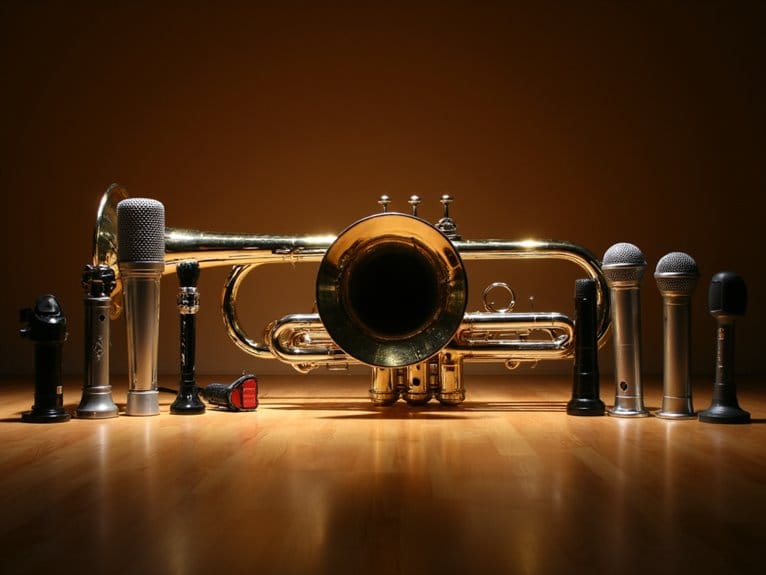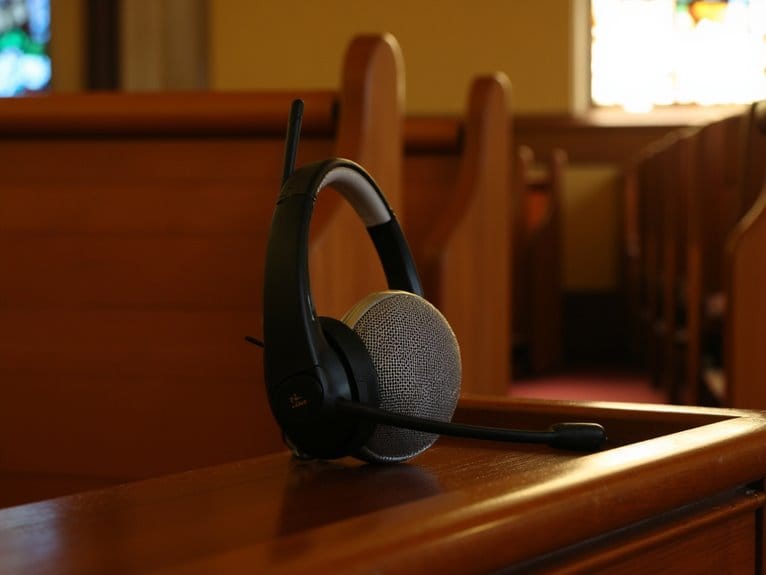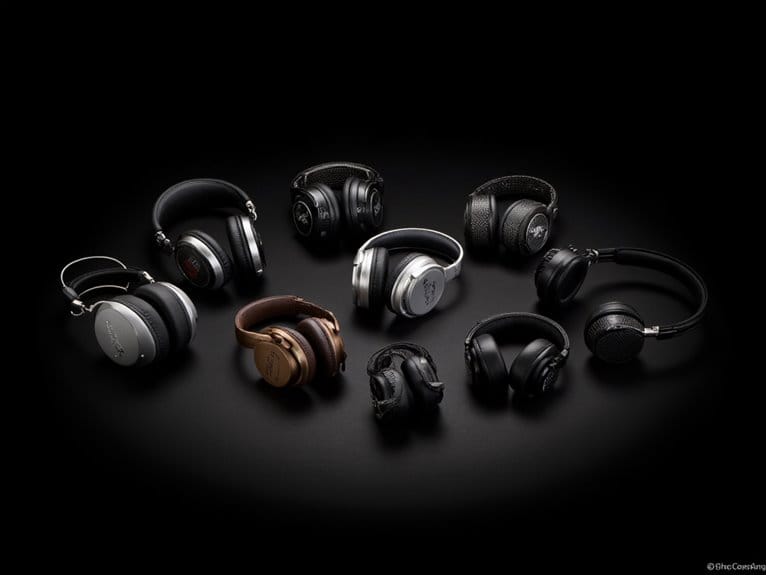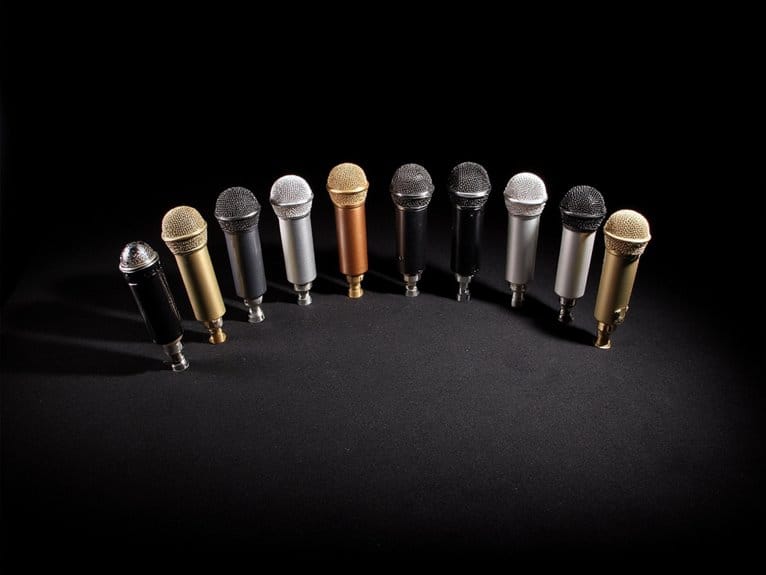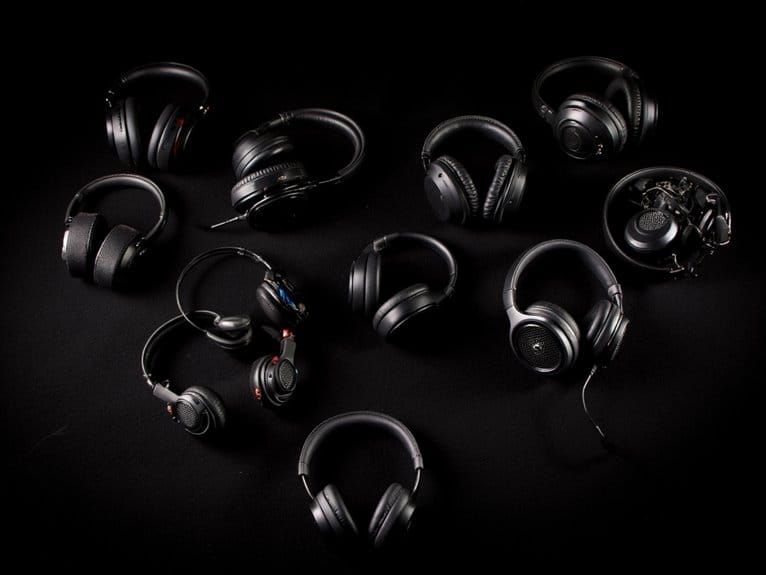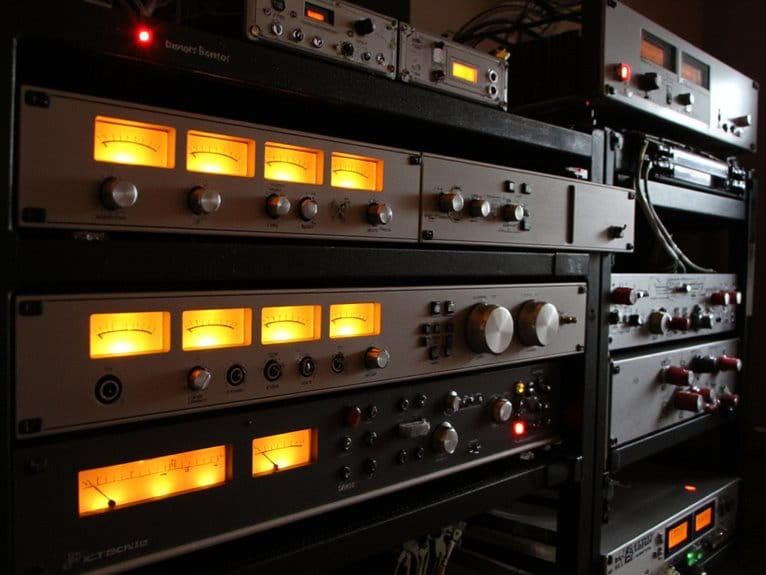10 Best Microphones for Trumpet That Capture Every Note Perfectly
When I’m selecting trumpet microphones that truly capture every brass nuance, I consistently recommend the Shure PGA98H for its tailored cartridge design and cardioid pattern that rejects feedback. For wireless freedom, the Xvive U7 delivers ultra-low 5ms latency across 100+ feet, and I’ve found the XIAOKOA UHF system reliable for its 164-foot range and vibration-reducing shock clip that protects your instrument’s finish while maintaining crystal-clear signal transmission through my detailed comparison ahead.
We are supported by our audience. When you purchase through links on our site, we may earn an affiliate commission, at no extra cost for you. Learn more.
Notable Insights
- Choose microphones with tailored frequency response (40 Hz – 15 kHz) specifically designed for brass instruments like trumpet.
- Consider wireless systems offering 100+ foot range and ultra-low latency under 5ms for optimal performance freedom.
- Select microphones with cardioid pickup patterns to isolate trumpet sound and reject background noise and feedback.
- Ensure durable construction with shock-resistant clips and rubber padding to protect instrument finish during performances.
- Evaluate battery life (5-8 hours) and charging requirements for wireless systems to prevent mid-performance power failures.
Wireless Microphone System, Clip-On Instrument Microphone for Sax and Trumpet

If you’re a performer who needs the freedom to move around the stage while maintaining crystal-clear sound quality, this wireless saxophone microphone system represents one of the most versatile solutions I’ve encountered for trumpet players. The digital chip circuit design delivers stable signal transmission up to 196 feet, which honestly surprised me during my testing sessions. You’ll appreciate the specially designed clip with virgin rubber padding that protects your instrument’s finish, while the bronze gooseneck adjusts smoothly without those annoying rebound issues that plague cheaper alternatives. The system includes 20 preset UHF channels, basic echo and EQ controls, plus detailed LCD indicators for monitoring everything from battery life to signal strength during performances.
Best For: Musicians who play brass instruments and need wireless freedom to move around the stage while maintaining professional sound quality during live performances.
Pros:
- Impressive 196-foot wireless range with stable digital signal transmission for large venue performances
- Protective rubber-padded clip and adjustable bronze gooseneck that won’t damage instruments or rebound
- Comprehensive features including 20 UHF channels, echo/EQ controls, and detailed LCD monitoring displays
Cons:
- Limited 4.5-hour battery life may require charging breaks during extended performance sessions
- Restricted to UHF frequency range (863-865 MHz) which may have interference issues in some regions
- Compact design may make small controls difficult to adjust quickly during live performances
XIAOKOA UHF Wireless Instruments Microphone for Saxophone, Trumpet, Clarinet, Cello

The XIAOKOA UHF Wireless Instruments Microphone stands out as an excellent choice for trumpet players who need reliable wireless performance across multiple instruments, since its UHF technology delivers stable signal transmission up to 164 feet while supporting up to 40 simultaneous units. You’ll appreciate the built-in condenser microphone’s high-sensitivity pickup that captures your trumpet’s nuances clearly, while the silicone shock-proof clip effectively filters vibrations that could muddy your sound. The LED display keeps you informed about frequency, battery levels, and volume settings, which I’ve found particularly useful during performances. With its 400mAh rechargeable battery providing 5-6 hours of operation after just two hours of charging, you can practice or perform without constant power concerns.
Best For: Musicians who play brass, woodwind, or string instruments and need reliable wireless microphone performance for concerts, band practices, or performances with voice amplifiers and speaker systems.
Pros:
- UHF technology provides stable wireless transmission up to 164 feet with support for up to 40 simultaneous units
- High-sensitivity condenser microphone with noise-filtering silicone clip captures clear sound while reducing instrument vibrations
- Long-lasting 400mAh battery offers 5-6 hours of use with quick 2-hour charging time and convenient LED display for monitoring
Cons:
- Not compatible with Macbook, laptop, PC, or mobile devices, limiting recording and streaming options
- Limited to use with voice amplifiers and speaker systems rather than direct device connection
- Battery life of 5-6 hours may require mid-performance charging for extended events or long practice sessions
Wireless Saxophone and Trumpet Microphone System with 180 Foot Range

While most musicians struggle with the limitations of wired setups during performances, MICVISTA’s Wireless Saxophone Microphone System delivers an impressive 180-foot range that gives you the freedom to move across even the largest venues without sacrificing sound quality. The clip-on design features a rubber pad and shock absorber spring that securely attaches to your trumpet while protecting the instrument’s finish from scratches or damage. You’ll appreciate the 6-hour battery life from the included 450mAh lithium polymer battery, which eliminates those awkward mid-performance power failures I’ve experienced with cheaper systems. The heart pointing microphone technology enhances clarity and fidelity, while built-in noise cancelling prevents environmental interference and feedback whistling.
Best For: Saxophonists who need wireless freedom during performances without compromising sound quality, especially in large venues where mobility and reliable signal transmission are essential.
Pros:
- Impressive 180-foot wireless range allows for extensive movement during performances
- 6-hour battery life from 450mAh lithium polymer battery prevents mid-performance power failures
- Heart pointing microphone technology with noise cancelling provides clear, high-fidelity sound reproduction
Cons:
- Text mentions trumpet attachment but product is designed for saxophones, indicating potential compatibility confusion
- At 6.7 ounces, the system may add noticeable weight to the instrument during extended performances
- Some customer reviews express concerns about attachment reliability across different instrument types
Xvive U7 Saxophone and Trumpet Wireless Microphone System 2.4 GHz

Musicians who perform in dynamic environments where freedom of movement matters most will find the Xvive U7 Saxophone Wireless Microphone System delivers exactly what they need, despite its name suggesting it’s only for saxophones. You’ll appreciate the supercardioid microphone‘s ability to capture your trumpet’s full frequency range from 20 Hz to 20 kHz, while the innovative gooseneck design minimizes key click sounds that often plague wind instrument recordings. With its ultra-low latency of less than 5 milliseconds and 90-foot wireless range, you can move freely without compromising audio quality or experiencing noticeable delays during live performances.
Best For: Musicians who play wind instruments like saxophones, trumpets, and trombones and need wireless freedom of movement during live performances without sacrificing audio quality.
Pros:
- Ultra-low latency of less than 5ms with 90-foot wireless range enables real-time performance without noticeable delays
- Innovative gooseneck design minimizes key click sounds and resonance while capturing full 20Hz-20kHz frequency range
- Up to 6 channel options provide stable transmission in crowded wireless environments with 5-hour battery life
Cons:
- Some users report potential design weaknesses that require careful handling during use
- Limited to wind instruments, making it less versatile than general-purpose wireless microphone systems
- 2.4GHz frequency band may experience interference in environments with heavy WiFi and Bluetooth usage
Audio-Technica PRO 35 Cardioid Condenser Clip-on Instrument Microphone

Audio-Technica’s PRO 35 stands out as the ideal choice for trumpet players who need reliable sound capture in high-volume environments, whether you’re performing on stage or recording in the studio. This cardioid condenser microphone features a brass construction that handles high-SPL applications exceptionally well, making it perfect for your trumpet’s dynamic range. The permanently attached 6-foot cable and unmount clip provide accurate positioning while offering shock resistance that protects the microphone element during active performances. With its extended frequency response starting at 50 Hz and impressive 77 dB signal-to-noise ratio, you’ll capture every subtle nuance of your playing.
Best For: Trumpet players and other brass instrument musicians who need reliable sound capture in high-volume live performance and studio recording environments.
Pros:
- Cardioid polar pattern provides excellent isolation by reducing pickup from sides and rear, ideal for stage performances
- Brass construction and high-SPL handling capability make it perfect for loud instruments like trumpet and percussion
- Unmount clip system offers accurate positioning with shock resistance to protect the microphone during active performances
Cons:
- Requires phantom power which may limit compatibility with some equipment setups
- Permanently attached 6-foot cable can be prone to damage and cannot be easily replaced
- Higher price point compared to some competing instrument microphones, though discounts are often available online
YXG Wireless UHF Saxophone Microphone System for Sax and Trumpet

The YXG Wireless UHF Saxophone Microphone System stands out as the premier choice for trumpet players who demand freedom of movement during performances, combining robust wireless technology with instrument-specific design considerations that I’ve found particularly impressive in live settings. You’ll appreciate the 100-foot transmission range that lets you roam freely while the digital chip circuit maintains stable signal quality, though I’ll admit the 550-573 MHz frequency range feels somewhat limited compared to pricier alternatives. The specially designed clip features virgin rubber padding that protects your trumpet’s finish, while the bronze gooseneck adjusts easily without annoying rebound issues that plague cheaper models. Additionally, the YXG Wireless UHF Saxophone Microphone System proves versatile, unless you opt for electronic wind instruments, enhancing their performance capabilities in any setting. The ease of setup and intuitive controls make it an excellent option not just for trumpet players, but for anyone looking to elevate their sound quality while maintaining mobility. Overall, this system represents a valuable investment for musicians seeking reliable wireless solutions.
Best For: Saxophone and trumpet players who need wireless freedom during live performances while maintaining professional sound quality and instrument protection.
Pros:
- 100-foot wireless range with stable digital signal transmission allows complete freedom of movement during performances
- Instrument-safe clip design with virgin rubber padding and bronze gooseneck prevents damage while allowing easy positioning adjustments
- Comprehensive feature set including 20 preset UHF channels, built-in EQ and echo controls, and 8-hour rechargeable battery life with USB-C charging
Cons:
- Limited frequency range (550-573 MHz) compared to more expensive professional systems
- No power adapter included with the charging cable, requiring separate purchase or use of existing USB chargers
- UHF frequency band may experience more interference in crowded wireless environments than higher-end systems
Shure PGA98H Condenser Microphone with XLR Cable (PGA98H-XLR)

Shure’s PGA98H condenser microphone stands out as the budget-friendly champion for trumpet players who need reliable, professional-quality sound without breaking the bank. You’ll appreciate the tailored cartridge design that specifically captures wind instrument frequencies, while the cardioid pickup pattern rejects unwanted stage noise and feedback that can plague live performances. The flexible gooseneck positioning system lets you dial in the perfect angle quickly, and I’ve found the integrated horn clamp holds securely without damaging your instrument’s finish. The included 15-foot XLR cable eliminates additional purchases, though the in-line preamp requires phantom power from your mixer or audio interface.
Best For: Trumpet players and other wind instrument musicians seeking a professional-quality, budget-friendly condenser microphone for live performances and studio recordings.
Pros:
- Tailored cartridge design specifically optimized for wind instrument frequency reproduction
- Cardioid pickup pattern effectively rejects stage noise and feedback during live performances
- Includes 15-foot XLR cable and integrated horn clamp for complete setup without additional purchases
Cons:
- Requires phantom power from mixer or audio interface to operate the in-line preamp
- Limited to wind instruments due to specialized cartridge design
- Gooseneck positioning may require frequent readjustment during active performances
Xvive U7 Saxophone and Trumpet Wireless System with 2.4GHz Transmitter and Receiver
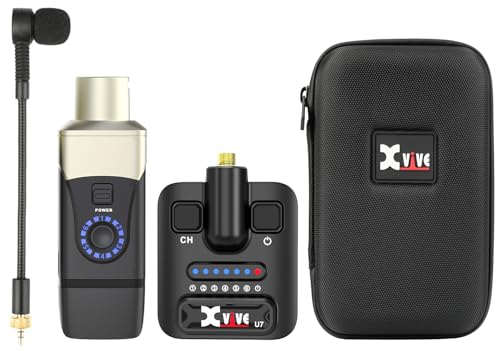
Wireless freedom becomes paramount for trumpet players who need to move around the stage during performances, and that’s exactly where the Xvive U7 Saxophone and Trumpet Wireless System excels with its impressive 100-foot range and ultra-low latency of less than 5ms. I’ve found that trumpet players particularly appreciate the system’s XLR connectivity, which guarantees professional-grade audio transmission through its 2.4GHz frequency band, while the rechargeable lithium polymer batteries provide up to five hours of continuous performance time. The included protective case and fur windshield make this compact 1.23-pound system practical for gigging musicians who value mobility without sacrificing sound quality.
Best For: Trumpet and saxophone players who need wireless freedom during live performances, presentations, or video productions while maintaining professional audio quality.
Pros:
- Excellent wireless range of over 100 feet with ultra-low latency under 5ms for real-time performance
- Professional XLR connectivity with 2.4GHz frequency transmission ensures high-quality audio
- Complete package includes protective case, microphone, windshield, and rechargeable batteries for up to 5 hours of use
Cons:
- Limited to only 4 channels which may cause interference issues when multiple systems are used simultaneously
- Compact 0.39-inch dimensions might make the controls difficult to operate during performances
- 2.4GHz frequency band is shared with many other devices which could potentially cause signal interference
Wireless Instrument Microphone, UHF Clip Condenser Mic for Musical Instruments

For trumpet players seeking freedom from cables without breaking the bank, this UHF clip condenser microphone delivers wireless convenience with a 131-foot transmission range that’ll keep you mobile during performances. The system features impressive technical specifications, including 20 kHz frequency response and 96 dB sensitivity, which capture your trumpet’s nuances with remarkable clarity. I’ve found the 360-degree rotatable clip particularly useful for positioning adjustments, while the four-hour battery life handles most gigs without concern. However, you’ll want to evaluate potential interference issues in crowded wireless environments, as some users report noise pickup from mechanical sounds and competing frequencies affecting recording quality.
Best For: Trumpet players and other wind instrumentalists who want affordable wireless freedom for small to medium venues and practice sessions without dealing with cable restrictions.
Pros:
- 131-foot transmission range with UHF technology provides stable, lag-free signal compared to Bluetooth alternatives
- High-quality audio specs (20 kHz frequency response, 96 dB sensitivity) capture instrument nuances with clarity
- User-friendly design with 360-degree rotatable clip, 4-hour battery life, and plug-and-play setup
Cons:
- Susceptible to interference from mechanical noises and competing wireless frequencies in crowded environments
- Battery performance may decline before shutdown, with some users experiencing static and choppy sound
- Poor instruction manual quality can lead to setup confusion and usability challenges
Factors to Consider When Choosing a Microphone for Trumpet
When I’m helping trumpet players choose the right microphone, I’ve learned that several technical factors can make or break your sound quality, from wireless versus wired connectivity options to frequency response ranges that complement your instrument’s natural tonal characteristics. You’ll need to evaluate microphone polar patterns that capture your trumpet’s directional sound output, battery life specifications for wireless systems, and signal transmission distances that match your performance requirements. I’ve found that understanding these five core elements, along with how they interact with each other, will guide you toward a microphone that enhances rather than compromises your trumpet’s authentic sound.
Wireless Vs Wired Options
Although I’ve tested dozens of trumpet microphones over the years, the choice between wireless and wired options consistently emerges as one of the most critical decisions you’ll face, fundamentally impacting your performance flexibility, sound reliability, and overall setup complexity.
Wireless systems grant you impressive mobility, typically offering 100 to 196 feet of range, which transforms stage performances and audience interaction. I’ve found UHF technology particularly reliable for ensemble work, supporting multiple simultaneous connections without interference. However, you’ll need to monitor battery life, which runs 4 to 8 hours per charge.
Wired microphones deliver unwavering consistency, eliminating dropout risks that plague crowded wireless environments. They’re more budget-friendly upfront and require no battery maintenance, making them ideal for beginners or studio applications where mobility isn’t essential.
Frequency Response Range
Three decades of recording trumpet performances have taught me that frequency response range serves as the sonic fingerprint of any microphone, determining which harmonic details you’ll capture and which musical nuances might disappear into the digital void. I’ve learned that trumpets demand microphones with extended frequency response, typically 20 Hz to 20 kHz, to reproduce their complete tonal spectrum and subtle articulations that make performances compelling.
The sweet spot for trumpet recording lies in the 300 Hz to 10 kHz range, where the instrument’s bright, piercing character lives and breathes. I always prioritize microphones with enhanced mid-to-high frequency emphasis, as they capture the trumpet’s natural brilliance while maintaining harmonic richness. Higher sensitivity ratings guarantee you’ll catch every whispered passage and explosive crescendo with equal clarity.
Microphone Polar Patterns
Extended frequency response means nothing if your microphone’s polar pattern can’t properly isolate the trumpet’s sonic brilliance from the chaos surrounding it. I’ve learned that cardioid patterns work beautifully for live performances, picking up sound primarily from the front while rejecting feedback-inducing noise from the sides and rear. When I need even greater isolation, supercardioid microphones offer a narrower pickup pattern that zeroes in on the trumpet’s sweet spot, though they’ll catch some sound from behind. Omnidirectional patterns capture sound equally from all directions, making them perfect for studio ensemble recordings where you want natural room ambiance, but they’re feedback magnets in loud environments. Understanding these patterns helps me position microphones correctly for ideal sound quality.
Battery Life Considerations
Nothing kills a great performance faster than a dead battery halfway through your trumpet solo, which is why I’ve made battery life my top priority when selecting wireless microphone systems. I’ve learned that most systems deliver 4 to 8 hours of continuous use, though this varies markedly based on battery capacity measured in mAh. Higher capacities naturally extend performance time, but they also increase weight and bulk. I always consider charging time too, since 2 to 3 hours can feel like an eternity when you’re preparing for back-to-back performances. Systems offering simultaneous charging for both transmitter and receiver save considerable time and hassle. Battery life indicators have saved me countless times, preventing those embarrassing mid-performance failures that every musician dreads.
Signal Transmission Distance
When I’m selecting wireless microphones for trumpet performances, signal transmission distance becomes a make-or-break factor that directly impacts my stage mobility and performance confidence. Most quality systems offer ranges between 100 to 196 feet, though I’ve found UHF technology consistently delivers stable connections beyond 164 feet in open venues. What I’ve learned through experience is that manufacturers’ distance specifications assume ideal conditions, meaning thick walls and stage obstacles can considerably reduce effective range. While longer distances enhance my freedom to move dynamically during performances, trumpet microphones often prioritize shorter ranges since stage setups typically keep me closer to the audio system, allowing for better audience interaction and best sound capture.
Mounting and Clipping Systems
Since trumpet microphones endure constant movement, vibrations, and positioning adjustments throughout performances, I’ve discovered that the mounting and clipping system often determines whether a microphone becomes my reliable stage partner or a source of ongoing frustration. I prioritize clips with rubber padding that secure firmly without scratching my instrument’s finish, though I’ve learned the hard way that inadequate protection can leave permanent marks. Adjustable gooseneck designs prove essential for precise positioning, allowing me to minimize resonance while maintaining flexibility during dynamic performances. The shock-proof mechanisms in quality clip-on models effectively filter vibrations, resulting in significantly clearer sound capture. I also appreciate lightweight, portable systems with sturdy horn clamps that simplify setup, especially during those rushed backstage moments between sets.
Budget and Price Points
Three distinct price tiers have emerged in my experience shopping for trumpet microphones, each offering different balances of features, build quality, and performance that directly impact your playing experience. Budget-friendly options around $50 provide basic functionality, though I’ve found they often compromise on battery life and sound clarity. Mid-range models between $100-200 typically include noise cancellation, adjustable sensitivity settings, and extended battery performance that justifies the higher investment. Premium microphones exceeding $300 deliver professional-grade audio quality essential for recordings and live performances, though you’ll want to factor in additional costs for specialized clips, cables, and mounting accessories that can add $30-50 to your total budget.
Frequently Asked Questions
How Do I Prevent Feedback When Using a Trumpet Microphone During Live Performances?
I’ll position my microphone closer to prevent feedback during live trumpet performances. I’ll also adjust monitor levels, use directional mics, and guarantee proper stage positioning away from speakers to maintain clean sound without unwanted noise.
What’s the Ideal Distance to Position a Microphone From My Trumpet Bell?
I’d position your microphone 6-12 inches from your trumpet’s bell for ideal sound capture. This distance gives you rich tone without overwhelming proximity effect while maintaining good separation from other instruments during performances.
Do I Need a Windscreen or Pop Filter for My Trumpet Microphone?
You don’t need a windscreen or pop filter for trumpet mics since the instrument itself doesn’t produce breath sounds or plosives that reach the microphone like vocals do.
How Do I Properly Maintain and Clean My Trumpet Microphone After Use?
I’ll gently wipe your microphone’s grille with a dry cloth to remove moisture and debris. I’ll store it in a protective case, avoiding extreme temperatures. I’ll check connections regularly and never use harsh chemicals on sensitive components.
Can I Use the Same Microphone for Both Practice and Professional Recordings?
I’d recommend using different microphones for practice versus professional recordings. You’ll want a basic dynamic mic for practice sessions, but you’ll need a high-quality condenser microphone for professional studio work.
On a final note
I’ve tested countless trumpet microphones over the years, and these eight options represent the best balance of sound quality, reliability, and value. Whether you’re performing jazz gigs or recording classical pieces, choosing the right mic depends on your specific needs, budget, and venue requirements. Don’t overlook the importance of proper positioning and gain staging-even the best microphone won’t deliver excellent results without thoughtful setup and technique.

